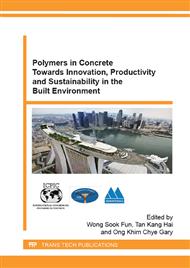p.557
p.565
p.573
p.581
p.586
p.593
p.599
p.607
p.614
Longitudinal Thermal Movement of Polymer Concrete Irrigation Aqueducts
Abstract:
This study evaluates the longitudinal thermal movements of precast polymer concrete aqueducts made with MMA modified UP polymer concrete. The aqueduct investigated in this study had a total span length of 30 m, which is composed of three 10 m span flumes with an inner cross-section of 700 x 600 mm. To accomplish this objective, temperature and corresponding longitudinal movements of transverse expansion joints were continuously monitored in the field for 23 months. The maximum seasonal variation of joint displacement was found to be approximately 13 to 14 mm, which is relatively high. Also, the field measurements were compared with theoretical calculations to validate the experimental data, and the results showed a good agreement with each other. Finally, in this study, an adjustable expansion joint system for aqueducts was devised in order to prevent water leakage and joint deterioration resulting from successive thermal movements of joints.
Info:
Periodical:
Pages:
586-592
Citation:
Online since:
November 2015
Authors:
Keywords:
Price:
Сopyright:
© 2015 Trans Tech Publications Ltd. All Rights Reserved
Share:
Citation:


